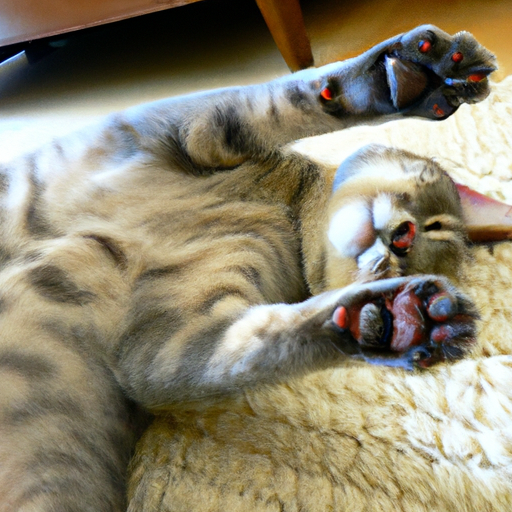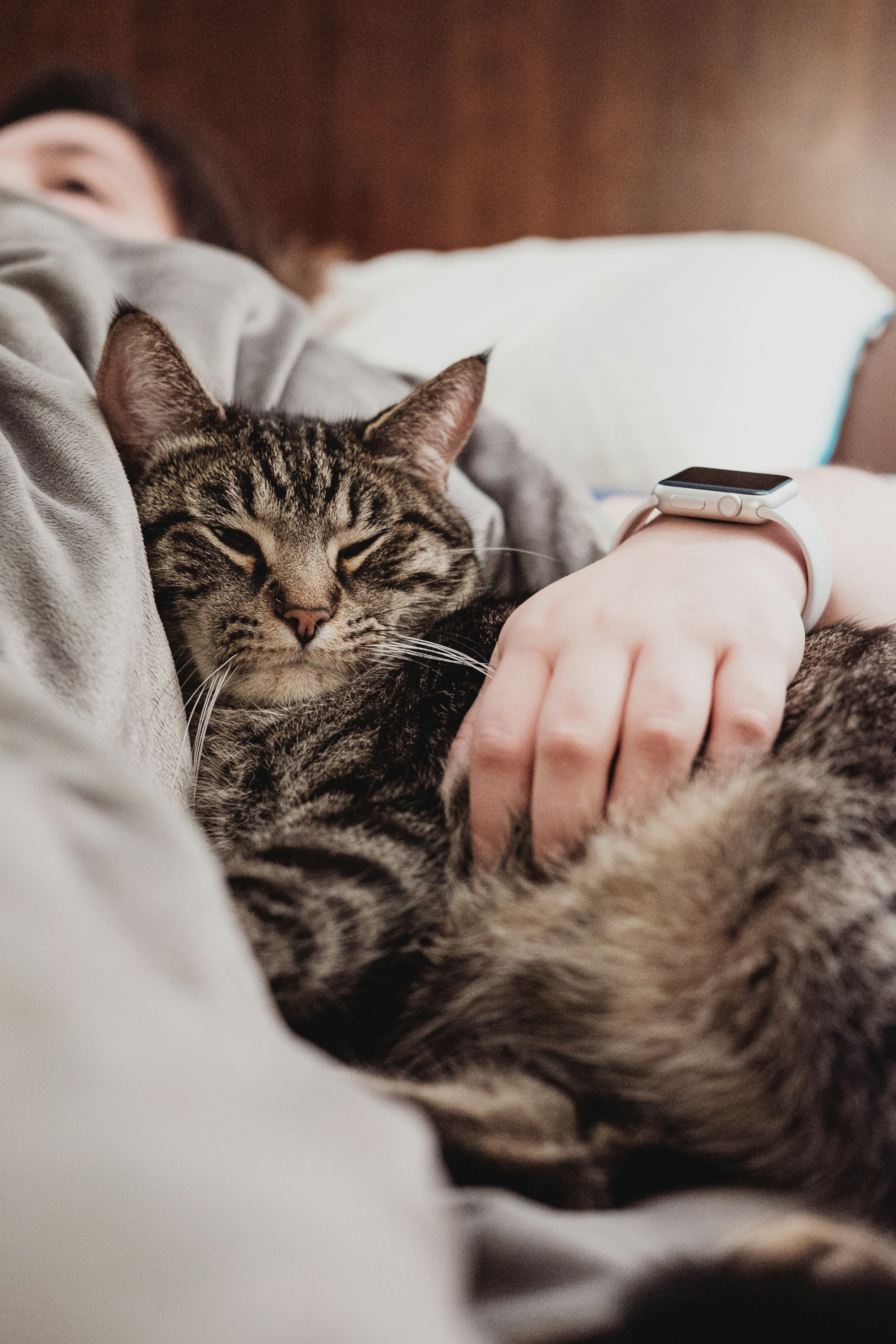Imagine this: you enter a room, and there, sprawled out on the floor is your beloved feline companion, lying on its back. You can’t help but wonder: why do cats lay on their backs? As a compassionate observer, you yearn to understand the motives behind this seemingly strange behavior. In this article, we will explore the fascinating reasons why cats choose to expose their vulnerable bellies in such a vulnerable position, and how it reflects their complex emotions and instinctual nature. Prepare to gain a deeper appreciation for the enigmatic world of our furry friends.
Instinctual Behavior
Stretching and Exercise
Cats have a natural instinct to stretch their bodies. When a cat lays on its back, it is an opportunity for them to stretch their muscles fully. By stretching their entire body, from their head to their tail, cats are able to release tension and maintain flexibility in their muscles and joints. This instinctual behavior helps them stay agile and prevents muscle stiffness and discomfort.
Exposing Vulnerable Areas
When a cat lays on its back, it is a vulnerable position for them. Exposing their belly and vital organs shows a display of trust and comfort in their environment. By exposing these vulnerable areas, cats are showing that they feel safe and secure in their surroundings. Cats typically only expose their bellies to individuals they trust, such as their owners. It is a sign that they feel comfortable and protected.
Release of Pheromones
Another reason why cats lay on their backs is to release their pheromones. Pheromones are chemical substances that cats use to communicate with each other. By laying on their backs and rubbing their scent glands against the surfaces they come into contact with, cats are marking their territory. This behavior is a way for cats to establish dominance and communicate their presence to other animals in their environment.
Displaying Trust and Comfort
Feeling Safe and Secure
When a cat lays on its back, it is a clear indication that they feel safe and secure in their surroundings. This behavior is commonly seen when cats are in a familiar and trusted environment, such as their own home. It shows that they trust their surroundings and the people around them. Cats have a strong instinct to protect themselves, and when they feel secure, they are more likely to display vulnerable behaviors like laying on their backs.
Inviting Belly Rubs
Laying on their backs also serves as an invitation for belly rubs. Many cats enjoy having their bellies scratched and rubbed, and when they lay on their backs, they are essentially presenting their bellies as an invitation for human interaction. It is a way for cats to seek attention and engage in bonding with their owners. However, it is important to note that not all cats enjoy belly rubs, and it is crucial to respect their preferences and boundaries.
Attention-seeking Behavior
Seeking Human Interaction
Cats are known for being independent animals, but they also desire human interaction and attention. When a cat lays on its back, it is one way for them to seek attention from their owners. By displaying their vulnerable belly and showcasing their trust, cats are subtly asking for interaction and affection. They may be seeking cuddles, pets, or simply just wanting to be in the presence of their human companion. It is essential for cat owners to respond to this behavior and provide the desired attention.
Demanding Playtime or Food
In addition to seeking attention, cats may also lay on their backs as a means of demanding playtime or food. Cats are intelligent creatures that quickly learn the cause and effect of their behavior. If a cat realizes that laying on its back leads to getting playtime or food, they may use this behavior as a way to communicate their desires. By displaying their vulnerability and seeking interaction, cats are using their instincts to communicate their needs to their owners.
Temperature Regulation
Cooling Down
Cats are known for their ability to regulate their body temperature. When a cat lays on its back, it is a way for them to cool down. By exposing their belly and spreading their limbs, cats allow air to circulate around their body, promoting heat dissipation. This behavior is particularly common in warmer climates or during hot weather when cats are trying to find ways to cool down and maintain a comfortable body temperature.
Warming Up
On the other hand, cats may also lay on their backs to warm up. In cooler temperatures, cats tuck their legs close to their body and curl up in a ball to conserve heat. However, when they lay on their backs, they are exposing their belly to absorb warmth from the environment, such as the sun or a heated surface. This behavior allows them to increase their body temperature and ensure their comfort in colder conditions.
Comfortable Sleeping Position
Relieving Muscle Tension
Cats spend a significant amount of their time sleeping, and when they lay on their backs, it is often a sign of relaxation and comfort. By stretching out their bodies and laying on their backs, cats are able to release muscle tension accumulated during their active periods. This position allows their muscles to relax fully, reducing any discomfort or stiffness. It is their instinctual way of finding a comfortable sleeping position that promotes overall physical well-being.
Enhancing Breathability
When cats lay on their backs, it also helps enhance breathability. By stretching out and opening up their body, cats are optimizing airflow, especially in their chest and stomach area. This position allows for efficient breathing and helps cats maintain a stable respiratory rate during sleep. It contributes to their overall comfort by ensuring proper oxygen intake and promoting a healthy sleeping pattern.
Marking Territory
Leaving Scent Marks
Cats have scent glands located on their paws and around their face. When a cat lays on its back and reaches out to objects or surfaces, they are leaving scent marks as a way of marking their territory. By rubbing their scent glands against different surfaces, cats are effectively communicating their presence and dominance to other animals. It is an instinctual behavior that allows cats to establish ownership and create a sense of familiarity in their environment.
Staking Claim
In addition to leaving scent marks, cats may also lay on their backs to stake claim to a particular space or object. By displaying their vulnerability and marking their territory, cats are communicating that they have ownership over a specific area or item. This behavior is often seen when cats encounter new objects or unfamiliar spaces, and it serves as a way for them to assert their dominance and establish a sense of security in their surroundings.
Flexible and Agile Body
Stretching the Spine
Cats are known for their incredible flexibility, and when they lay on their backs, it is an opportunity for them to stretch their spines. By arching their back and extending their body, cats can maintain the flexibility and mobility of their spine. This behavior helps them stay agile and enables them to execute quick and precise movements when hunting or playing. It is an instinctual behavior that contributes to their overall physical well-being.
Maintaining Flexibility
In addition to stretching their spines, laying on their backs also allows cats to maintain flexibility in their limbs and joints. Cats rely on their flexibility to navigate through various environments, climb, and pounce on prey. When they stretch their limbs and extend their full body on their backs, they are exercising their muscles and ensuring optimal functionality. This behavior is crucial for their overall physical health and helps prevent muscle stiffness or joint discomfort.
Curiosity and Exploration
Observing Surroundings
Cats are naturally curious creatures, and when they lay on their backs, it provides them an ideal vantage point to observe their surroundings. By exposing their belly and reclining on their backs, cats have a broader view of the environment and can keep an eye on any potential threats or sources of interest. This behavior allows them to satisfy their curiosity and engage with their surroundings in a more relaxed and comfortable manner.
Reaching Underneath Objects
Laying on their backs also enables cats to reach underneath objects and explore hidden areas. By extending their limbs and contorting their body, cats can manipulate their surroundings and investigate spaces that may be otherwise inaccessible. This behavior showcases their agility and problem-solving abilities. Cats often display this behavior when they are trying to retrieve a toy, catch a prey, or simply explore their environment in a more thorough and comprehensive manner.

Attention-seeking from Other Animals
Interacting with Other pets
While cats are often portrayed as independent animals, they also enjoy the company of other pets. When a cat lays on its back, it can serve as a way to seek attention and interaction from other animals in the household. By exposing their belly and displaying vulnerable behavior, cats are inviting playfulness and social engagement with their furry companions. This behavior fosters companionship and strengthens the bond between animals in a multi-pet household.
Instigating Playfulness
In addition to seeking attention, cats may lay on their backs to instigate playfulness in other animals. By exposing their belly and displaying a vulnerable position, cats are inviting other animals to engage in interactive play sessions. This behavior is often accompanied by pawing, rolling, or playfully swatting at their companions. It serves as a way for cats to initiate playful interactions and create a stimulating and engaging environment for themselves and their fellow pets.
Natural Sunbathing Behavior
Absorbing Vitamin D
Cats are known for their fondness for soaking up the sun, and when they lay on their backs, it is often an opportunity for them to absorb essential Vitamin D from sunlight. Sunbathing helps cats regulate their calcium and phosphorus levels, which are essential for healthy bones and teeth. By exposing their belly and positioning themselves to soak up the sun’s rays, cats are instinctually providing themselves with an essential nutrient intake to support their overall well-being.
Enjoying Warmth
In addition to the health benefits, cats also enjoy the warmth that sunbathing provides. When they lay on their backs and position themselves under the sun, cats can bask in the comforting and soothing warmth. This behavior promotes relaxation and helps cats unwind and recharge. The warmth of the sun’s rays soothes their muscles, alleviates any discomfort, and contributes to their overall physical and mental satisfaction.
In conclusion, cats lay on their backs for various instinctual reasons. Whether it be stretching their muscles, displaying trust and comfort, seeking attention, regulating their body temperature, finding a comfortable sleeping position, marking territory, maintaining flexibility, satisfying their curiosity, seeking interaction from other animals, or enjoying the benefits of sunbathing, this behavior is deeply rooted in their natural instincts. Understanding these behaviors can help cat owners better comprehend their feline companions and cater to their unique needs and preferences. So the next time you see your cat laying on its back, take a moment to appreciate the intricate instincts and behaviors that make them such fascinating creatures.




